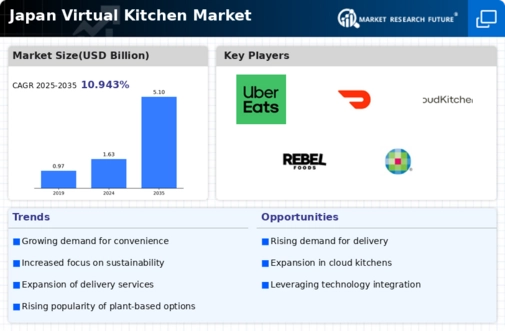The virtual kitchen market in Japan is currently characterized by a dynamic competitive landscape, driven by evolving consumer preferences and technological advancements. Key players such as CloudKitchens (US), Rebel Foods (IN), and Kitchen United (US) are actively shaping the market through innovative strategies and operational efficiencies. CloudKitchens (US) has positioned itself as a leader in the sector by focusing on rapid expansion and leveraging data analytics to optimize kitchen operations. Meanwhile, Rebel Foods (IN) emphasizes a diverse brand portfolio and aggressive digital marketing strategies to capture a broader customer base. Kitchen United (US) is also notable for its partnerships with established restaurant brands, enhancing its market presence and operational capabilities. Collectively, these strategies contribute to a competitive environment that is increasingly focused on efficiency and customer engagement.
In terms of business tactics, companies are increasingly localizing their operations to better cater to regional tastes and preferences. This localization, coupled with supply chain optimization, is essential in a market that appears moderately fragmented, with numerous players vying for market share. The collective influence of these key players is significant, as they not only drive innovation but also set benchmarks for operational excellence within the industry.
In October 2025, Rebel Foods (IN) announced a strategic partnership with a leading Japanese food delivery service to enhance its delivery capabilities in the region. This move is strategically important as it allows Rebel Foods to tap into the local market more effectively, leveraging the established logistics network of its partner. Such partnerships are likely to enhance customer satisfaction and operational efficiency, positioning Rebel Foods favorably against its competitors.
In September 2025, CloudKitchens (US) launched a new initiative aimed at integrating AI-driven analytics into its kitchen management systems. This initiative is significant as it not only streamlines operations but also enhances decision-making processes, allowing for more responsive adjustments to menu offerings based on real-time consumer data. The integration of AI is indicative of a broader trend towards digital transformation within the industry, which is likely to redefine operational standards.
In August 2025, Kitchen United (US) expanded its footprint by opening new locations in key urban areas across Japan, focusing on high-demand neighborhoods. This expansion is crucial as it positions Kitchen United to capitalize on the growing trend of urbanization and the increasing demand for convenient food options. By strategically placing its kitchens in densely populated areas, the company enhances its accessibility and service efficiency, which could lead to increased market share.
As of November 2025, the competitive trends within the virtual kitchen market are increasingly defined by digitalization, sustainability, and the integration of advanced technologies such as AI. Strategic alliances are becoming more prevalent, as companies recognize the value of collaboration in enhancing service delivery and operational efficiency. Looking ahead, competitive differentiation is likely to evolve from traditional price-based competition to a focus on innovation, technological advancements, and supply chain reliability. This shift suggests that companies that prioritize these areas will be better positioned to thrive in an increasingly competitive landscape.
















Leave a Comment